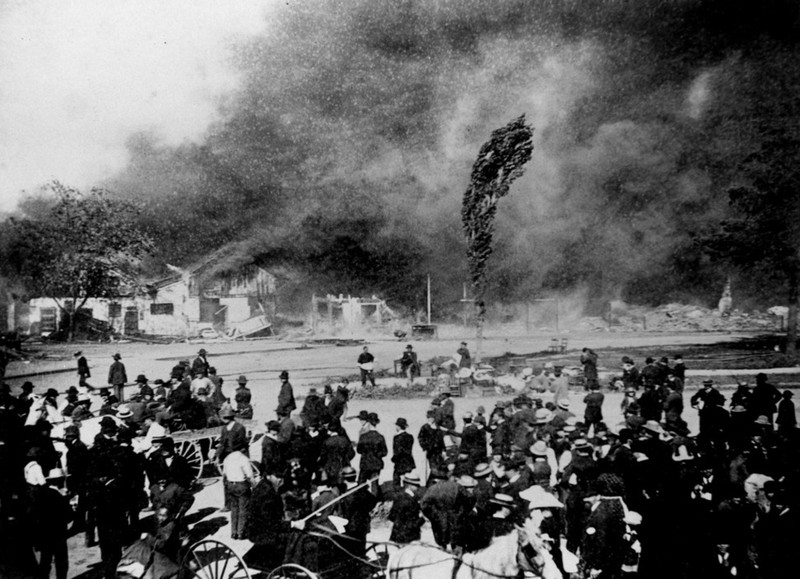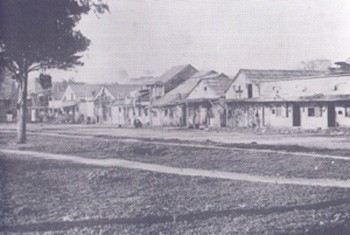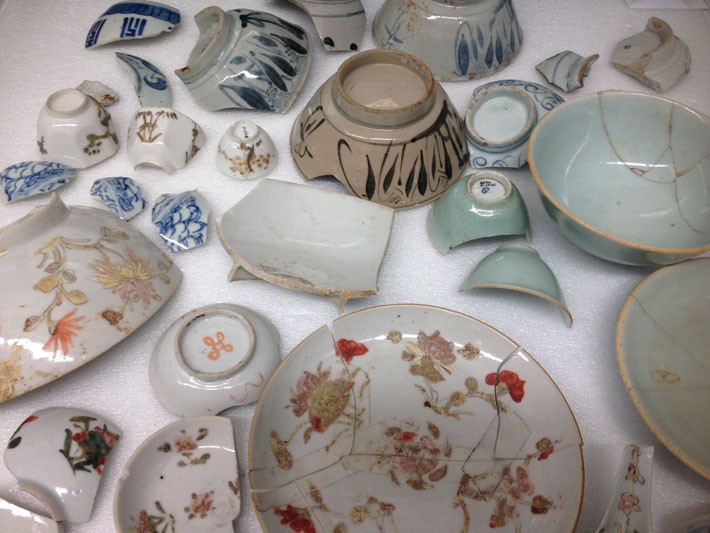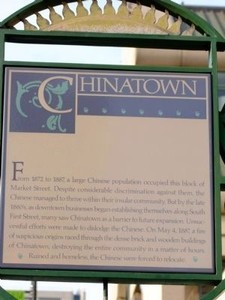Market Street Chinatown Historic Marker
Introduction
Text-to-speech Audio
Images
The Market Street Chinatown fire (image from History San Jose)

Market Street Chinatown in 1880 (image from History San Jose)

Ceramics recovered during archaeological excavations at Market Street (image from Archaeology Magazine)

This Chinatown historic marker is located outside the Fairmont Hotel at the intersection of Market Street and Paseo de Santo Antonio.

Backstory and Context
Text-to-speech Audio
San Jose's Early Chinatown
During the 19th century, so-called "Nativist" European American prejudices were rampant in California, and Chinatowns of the West were often safe, economically stable communities not only for Chinese Americans, but Japanese and other Asian Americans, Native Americans, African Americans, European immigrants, and white social outcasts such as prostitutes [1]. Analysis of artifacts from San Jose's Market Street Chinatown has revealed a combination of pan-Asian, British, and American household goods were used in the community, suggesting a diverse, mobile (not isolated) population who were an important part of the county's economic development [1; 2; 3]. University of Delaware professor Jean Pfaelzer writes that San Jose's Chinatown was "the economic and social center for three thousand farmworkers, for domestic servants...and for local Chinese merchants and laborers," [quoted in 4].
Anti-Chinese sentiment rose in part from European American ignorance of Chinese goods, culture, and tradition, but also from the more mundane issue of business interests [1; 3]. Despite beatings, murders, and arson from European Americans, Market Street Chinatown managed to thrive. The residents even organized their own fire department in 1883 [3]. As downtown San Jose grew in the 1880s, businessmen eyed the properties of Chinatown as sites of future expansion, and Mayor C.W. Breyfogle and the town council declared the community a "public nuisance," voting to remove it in March of 1887 [1; 3]. After two months without success, an arson fire set on May 4, 1887 destroyed the densely-packed brick and wooden buildings of Chinatown within hours [3; 4]. The fire was set in an alley during the afternoon, when most of the community were gathering to hear the announcement of the lottery winner, and although the Chinese fire brigade responded to the blaze, their water tank proved to have been drained. Nearby white business owners had spent the previous two weeks investing in fire insurance, according to Pfaelzer [quoted in 3].
The tragedy left San Jose's Chinatown residents homeless and
destitute, though the fire helped to preserve their community's archaeological
record, which was excavated in the 1980s during urban redevelopment of the
downtown area [1; 2; 3]. Over 50,000 artifacts were recovered; analysis began
in 2001 and is still ongoing [1; 2]. For more of the history of San Jose's
Chinatown community following the destruction at Market Street, see the entry
on the Chinese American
Historical Museum.
Sources
1. Patel, Samir S. "Culture
in Chinatowns of the American West." Archaeology Magazine, Archaeological
Institute of America. April 8, 2014. Accessed December 28, 2016. http://www.archaeology.org/issues/136-features/chinatowns/1956-culture-in-chinatowns-american-west.
2. Stanford University.
"Market Street Chinatown Archaeological Project." Accessed December
28, 2016. http://marketstreet.stanford.edu/.
3. Yee, Jordan. "The Burning of San Jose Chinatown." Historical Marker Database. January 4, 2010. Accessed December 17, 2016. http://www.hmdb.org/Marker.asp?Marker=26215.
4. Yee, Jordan.
"Chinatown." Historical Marker Database. January 5, 2010. Accessed
December 17, 2016. http://www.hmdb.org/Marker.asp?Marker=26214.
